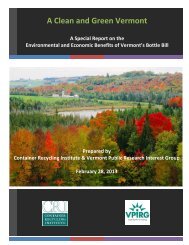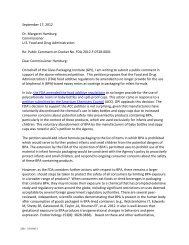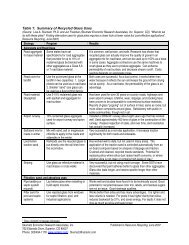First step, partner up BY CONNI KUNZLER - Glass Packaging Institute
First step, partner up BY CONNI KUNZLER - Glass Packaging Institute
First step, partner up BY CONNI KUNZLER - Glass Packaging Institute
You also want an ePaper? Increase the reach of your titles
YUMPU automatically turns print PDFs into web optimized ePapers that Google loves.
oute to establish economic feasibility. One<br />
survey respondent stated that the minimum<br />
threshold for a once per week glass collection<br />
route is between 50 and 75 participating<br />
businesses within a designated area.<br />
This, however, varies for each program and<br />
the volume of glass containers generated at<br />
each business.<br />
There can be challenges with outside<br />
storage space and enclosure limitations. “A<br />
lot of these streets and structures were not<br />
built for recycling,” says Barton. “So getting<br />
a truck in and out of alleys and other dense<br />
areas can create a space problem.” It’s also<br />
necessary to work with property managers.<br />
A property manager may not want to<br />
participate even though the leasing business<br />
does. This adds another layer to issues of<br />
participation and access to outside recycling<br />
storage locations.<br />
Target a closed-loop<br />
end market<br />
In all programs surveyed, the collected glass<br />
containers are used in the manufacture of<br />
22 RR | October 2011<br />
new glass bottles and jars or to make fiberglass<br />
insultation. This is largely because the<br />
glass bottles are being collected separated<br />
from other recyclables (six programs), thus<br />
bypassing the MRF and going directly to a<br />
cullet processor.<br />
Recycled glass bottles collected single<br />
stream are taken first to a MRF (six programs)<br />
and then to the cullet processor.<br />
There is no data in this survey on recycled<br />
glass loss through this process, although a<br />
2009 Container Recycling <strong>Institute</strong> study<br />
found that for single-stream curbside collection,<br />
40 percent of glass gets recycled<br />
into new glass containers, on average, and<br />
another 40 percent ends <strong>up</strong> in landfills;<br />
the remaining 20 percent is presumably<br />
going to a secondary use.<br />
“Make sure recycling facilities can<br />
manage the flow of materials. While<br />
it’s easy to collect glass containers, the<br />
biggest issue is at the MRF to make glass<br />
a viable product,” says Bill Worrell from<br />
the San Luis Obispo County (California)<br />
Integrated Waste Management Authority.<br />
“MRFs are set <strong>up</strong> so that it goes through<br />
a series of screens, and while we’re able to<br />
create a viable glass products for making<br />
new glass bottles with very little going to<br />
landfill, not all MRFs can.” In California,<br />
the state’s beverage container redemption<br />
program provides an incentive to recycle<br />
glass.<br />
As the glass container industry pushes<br />
forward to increase the amount of recycled<br />
glass it uses to make new glass bottles<br />
and jars, it’s clear that bar, restaurant and<br />
hotel programs have an important role.<br />
Both the volume and quality of recycled<br />
glass coming out of these programs is<br />
significant. To make this happen, glass<br />
container manufacturers will need to<br />
continue efforts to <strong>step</strong> <strong>up</strong> outreach and<br />
<strong>partner</strong> with recycling collectors, communities<br />
and other local resources to<br />
stimulate more foodservice glass recycling<br />
programs.<br />
Reprinted with permission from Resource<br />
Recycling, P.O. Box 42270, Portland, OR<br />
97242-0270; (503) 233-1305, (503) 233-<br />
1356 (fax); www.resource-recycling.com.






